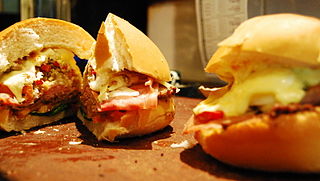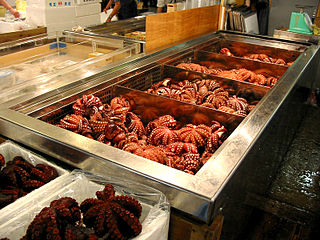
Argentine cuisine is described as a blending of cultures, from the Indigenous peoples of Argentina who focused on ingredients such as humita, potatoes, cassava, peppers, tomatoes, beans, and yerba mate, to Mediterranean influences brought by the Spanish during the colonial period. This led to cultural blending of criollos, Indigenous, and sub-Saharan African in the cuisine. Later, this was complemented by the significant influx of Italian and Spanish immigrants to Argentina during the 19th and 20th centuries, who incorporated plenty of their food customs and dishes such as pizzas, pasta and Spanish tortillas.

Pizza is an Italian dish consisting of a flat base of leavened wheat-based dough topped with tomato, cheese, and other ingredients, baked at a high temperature, traditionally in a wood-fired oven.

Latin American cuisine is the typical foods, beverages, and cooking styles common to many of the countries and cultures in Latin America. Latin America is a highly racially, ethnically, and geographically diverse with varying cuisines. Some items typical of Latin American cuisine include maize-based dishes arepas, empanadas, pupusas, tacos, tamales, tortillas and various salsas and other condiments. Sofrito, a culinary term that originally referred to a specific combination of sautéed or braised aromatics, exists in Latin American cuisine. It refers to a sauce of tomatoes, roasted bell peppers, garlic, onions and herbs. Rice, corn, pasta, bread, plantain, potato, yucca, and beans are also staples in Latin American cuisine.

The milanesa is a variation of the Lombard veal Milanese, or the Austrian Wiener schnitzel, where generic types of breaded cutlet preparations are known as a milanesa.

Farinata, farinata di ceci, torta di ceci, fainé, fainá, socca,cecìna or cade is a type of thin, unleavened pancake or crêpe made from chickpea flour.

Parmigiana, also called parmigiana di melanzane or melanzane alla parmigiana, is an Italian dish made with fried, sliced eggplant layered with cheese and tomato sauce, then baked. The origin of the dish is claimed by the Southern regions of Calabria, Campania, Apulia and Sicily. Other variations found outside Italy may include chicken, veal, or another type of meat cutlet or vegetable filling.

Chivito is the national dish of Uruguay. It is a sandwich of sliced beefsteak (churrasco), mozzarella, ham, tomatoes, mayonnaise and black or green olives. A chivito commonly also includes bacon and fried or hard-boiled eggs. It is served in a bun, often accompanied by French-fried potatoes. Other ingredients, such as red beets, peas, grilled or pan-fried red peppers, and slices of cucumber, may be added.

Uruguayan cuisine is a fusion of cuisines from several European countries, especially of Mediterranean foods from Spain, Italy, Portugal and France. Other influences on the cuisine resulted from immigration from countries such as Germany and Scotland. Uruguayan gastronomy is a result of immigration, rather than local Amerindian cuisine, because of late-19th and early 20th century immigration waves of, mostly, Italians. Spanish influences are abundant: desserts like churros, flan, ensaimadas yoo (Catalan sweet bread), and alfajores were all brought from Spain. There are also all kinds of stews known as guisos or estofados, arroces, and fabada. All of the guisos and traditional pucheros (stews) are also of Spanish origin. Uruguayan preparations of fish, such as dried salt cod (bacalao), calamari, and octopus, originate from the Basque and Galician regions, and also Portugal. Due to its strong Italian tradition, all of the famous Italian pasta dishes are present in Uruguay including ravioli, lasagne, tortellini, fettuccine, and the traditional gnocchi. Although the pasta can be served with many sauces, there is one special sauce that was created by Uruguayans. Caruso sauce is a pasta sauce made from double cream, meat, onions, ham and mushrooms. It is very popular with sorrentinos and agnolotti. Additionally, there is Germanic influence in Uruguayan cuisine as well, particularly in sweet dishes. The pastries known as bizcochos are Germanic in origin: croissants, known as medialunas, are the most popular of these, and can be found in two varieties: butter- and lard-based. Also German in origin are the Berlinese known as bolas de fraile, and the rolls called piononos. The facturas were re-christened with local names given the difficult German phonology, and usually Uruguayanized by the addition of a dulce de leche filling. Even dishes like chucrut (sauerkraut) have also made it into mainstream Uruguayan dishes.
Panamanian cuisine is a mix of Spanish, Indigenous, and African techniques, dishes, and ingredients, reflecting its diverse population. Since Panama is a land bridge between two continents, it has a large variety of tropical fruits, vegetables and herbs that are used in native cooking.

Quibebé, kiveve, or quibebe is a popular dish of semi-sweet winter squash stew or purée in Paraguayan, Northeastern Brazilian, and the North-Eastern Argentina gastronomies. It has a doughy texture and is of creamy consistency. Its taste is very pleasant and the primary ingredient is a pumpkin fruit that is called by the guarani name, "andaí" or "zapallo anco" of Cucurbita moschata. The fruit is a squash that may be elongated or spherical, and its exterior color ranges from green to orange, to reddish. The pulp is orange color, compact, of firm texture, and has a sweet flavor.

Salsa golf is a cold sauce of somewhat thick consistency, common in Argentina. It is made from mayonnaise with a smaller amount of tomato-based sauce such as ketchup, as well as seasonings including pimento, oregano, and cumin.

Cheese soup is a type of soup prepared using cheese as a primary ingredient, along with milk, broth and/or stock to form its basis. Various additional ingredients are used in its preparation, and various types and styles of cheese soup exist. It is a part of some cuisines in the world, such as American, Colombian, Mexican, Swiss, French, and Tibetan cuisines. Mass-produced cheese soups may be prepared with the addition of food additives to preserve them and enhance flavor. A list of cheese soups is included in this article.

People of some cultures eat octopus. The arms and sometimes other body parts are prepared in various ways, often varying by species and/or geography.

Chahan, also known as Yakimeshi, is a Japanese fried rice dish prepared with rice as a primary ingredient and myriad additional ingredients and seasonings. The dish is typically fried, and can be cooked in a wok. Chahan may have originated in the 1860s from Chinese immigrants arriving at the port of Kobe. Chahan is a staple food in homes in Japan. Some restaurants outside Japan serve the dish as a part of their fare.

A combination meal, often referred as a combo-meal, is a type of meal that typically includes food items and a beverage. They are a common menu item at fast food restaurants, and other restaurants also purvey them. Combination meals may be priced lower compared to ordering items separately, but this is not always the case. A combination meal is also a meal in which the consumer orders items à la carte to create their own meal combination.

Deep-fried avocado is a dish prepared using avocado that has been breaded or battered and deep-fried. Panko bread crumbs are sometimes used. The dish can be stuffed with meats, cheese and other ingredients. The avocado inside the breading or batter may melt after the deep frying occurs. Deep-fried avocado with an egg placed inside the avocado is a breakfast dish. Deep-fried avocado is also used as a main ingredient in deep-fried avocado tacos, as an additional ingredient or topping in tacos, and sometimes as a hamburger topping.














